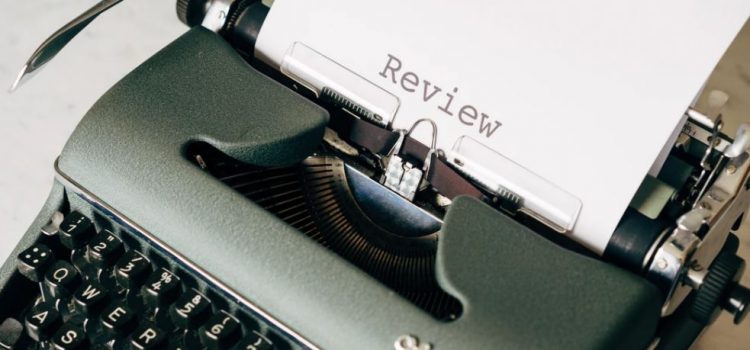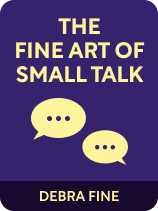

This article is an excerpt from the Shortform book guide to "The Fine Art of Small Talk" by Debra Fine. Shortform has the world's best summaries and analyses of books you should be reading.
Like this article? Sign up for a free trial here .
Is Debra Fine’s book The Fine Art of Small Talk worth reading? What did the critics have to say after the book’s release?
According to Debra Fine, small talk is a skill well worth developing because our careers, romantic prospects, and social lives depend on connecting with other people. It’s difficult to succeed socially without small talk because it establishes the emotional tone of our interactions and helps us gauge how deeply we’d like to connect with each other.
Here is our full The Fine Art of Small Talk review including a discussion about the book’s context, approach, and organization.
The Fine Art of Small Talk: Book Overview
In The Fine Art of Small Talk, Debra Fine explains the benefits of mastering small talk and teaches you to confidently converse with strangers. She argues that networking of all kinds is useful on a daily basis: Opportunities to chat with neighbors, coworkers, business prospects, clients, and possible romantic partners abound. Therefore, if you’re not comfortable and confident in engaging in conversation, you’ll miss out on all manner of connections.
In this guide, you’ll learn how to start and maintain conversations with strangers by asking genuine questions, listening attentively, and following up on details. You’ll also learn how to keep your conversation focused and how to make a graceful exit. By the guide’s end, you’ll be prepared to create icebreakers, talk about yourself, and make a good impression, regardless of the conversation’s context.
About the Author
Debra Fine is a bestselling author, keynote speaker, and internationally recognized communication expert. Fine says she used to dread small talk, public speaking, and meeting strangers until she realized these were skills she could study and practice. After researching and experimenting with small talk, she founded her company, The Fine Art of Small Talk, to teach everyone from mid-level managers to stakeholders communication skills for business and client meetings. From her office in Denver, Colorado, she offers programs on small talk, conversation skills, and networking. She’s also hosted workshops and training seminars all over the United States, Europe, and Asia.
Fine has shared her expertise with thousands of clients from Fortune 500 companies, professional groups, and major universities—Google, Lockheed Martin, the American Bar Association, and the Texas Association of School Boards among them. She’s also shared her insights on small talk on The Today Show, NPR Morning Edition, Fox Business News, and CNN.
The Book’s Publication
The Fine Art of Small Talk was published in 2005 by Hachette Books. An ebook version was published by Hyperion later the same year, as well as an audiobook. Since 2005, the book has been translated and published in more than 20 countries.
Since the publication of The Fine Art of Small Talk in 2005, Fine has expanded the Fine Art series to include two more books. The Fine Art of the Big Talk is a book for administrators, managers, and CEOs, detailing how to have tough conversations with suppliers, bosses, and subordinates. She wrote her latest book, Beyond Texting, to help teenagers—particularly those used to communicating online—master face-to-face communication. Of all of Fine’s books, The Fine Art remains her most successful.
Intellectual Context
The questions of how to start a conversation and how to keep one going are likely as old as communication itself, and they continue to be debated today. Countless blogs, forums, podcasts, and authors have contributed to this discussion, with great interest from listeners and readers. For example, Dale Carnegie’s How to Win Friends and Influence People has sold over 30 million copies since its publication in 1936 and, in 2011, was number 19 on Time Magazine’s list of the 100 most influential books.
What makes Fine’s advice stand out from other famous books on communication is that she focuses on the details of small talk rather than a high-level overview of conversation. Where Dale Carnegie, for example, operates on a meta level, discussing the ends for which conversation is a means, Fine directly explains what to say, how to say it, and who to say it to. She gives example dialogues, provides her readers with lists of questions to ask and statements to follow up with, and prepares you for the work of conversation.
Often, the people who produce small talk and conversational-skill-related content come from a business background. Their intended audience tends to be businesspeople, managers, or aspiring businesspeople and managers. In short, they come from a world in which small talk is ubiquitous, necessary, and purposeful.
In contrast, Fine—while she has since become a businessperson and manager—was initially an engineer, a career-class perhaps hyperbolically famous for drawing poor conversationalists. Her claim to authority on the topic of small talk is arguably grounded in the fact that small talk didn’t always come naturally to her—she developed her skill by reading books, studying those around her, and experimenting. Her message is: “I wasn’t an expert, but I became one. If I can do it, you can, too—no matter who you are.”
The Book’s Impact
Perhaps the greatest indicator of The Fine Art of Small Talk’s impact is that ten years after its publication, people still invite Fine to talk about it on podcasts and in articles. For instance, in July 2020, The Rotarian featured her in an article about using small talk to reconnect with others post-pandemic.
Furthermore, during the Covid-19 pandemic, when communication became more difficult due to enforced isolation, many publications turned to Fine for advice on conversing in these challenging circumstances. For example, a May 2021 article on MarketWatch highlighted Fine’s recommendation that we avoid gloomy hand-wringing to keep our conversations uplifting. Similarly, a Huffpost article published a month prior focused on Fine’s recommendation that we prepare conversation topics in advance of a conversation.
Critical Reception
The online reviews of The Fine Art of Small Talk are primarily positive. Those who praise it note that Fine’s suggestions are highly actionable, that she presumes no prior knowledge, and that she provides copious guidance on the navigation of a conversation. Those who feel helpless at small talk express particular appreciation for Fine’s tips on coming up with conversational topics.
Meanwhile, the most common complaints from reviewers are that the book is repetitive, that it’s full of anecdotal fluff, and that the example questions, icebreakers, and conversation topics are often awkward or robotic. (In some cases, the examples suffer simply because they’re dated: Asking “how has the internet affected your life” would not have elicited the same scorn in 2008 as it might today, for example.) Finally, some readers claim that Fine’s recommendations are just common sense and therefore unworthy of a book.
Commentary on the Book’s Approach
Fine writes in a clear, logical style, explaining why small talk matters, what purpose it serves, and how to approach it. She frequently provides example dialogues to show how a principle should be applied. Furthermore, she often includes anecdotes about how applying her principles of small talk helped her achieve her goals.
Generally, chapters begin with a small recap, an introduction to the main point, and an anecdote. Fine explains the issue at hand—the importance of listening visibly, for example—by describing a personal experience in which it went badly, explaining the mechanics and value of the principle before describing how to put it into practice. This provides context for the lessons she shares and helps to explain their use.
Each chapter typically includes lists of questions, conversation-openers or closers, or topics to bring up or avoid in various contexts. Chapter 2, for instance, ends with 70 icebreaker questions for business and social settings. As reviewers noted, in many cases, these example questions are strange, awkward, or stilted. You might never ask another person, for instance, to “tell you about one of [their] favorite relatives” or what they’d like to be reincarnated as. However, these lists can be helpful in showing that there’s a lot we can talk to each other about. Indeed, they arguably illustrate one of Fine’s primary points—that often, the fact that we’re talking to each other at all is more important than what we’re talking about.
Commentary on the Book’s Organization
Fine presents each principle in order, in a generally logical fashion: She walks the reader step-by-step through the process of conversation, from opening to exit, albeit with a few detours along the way.
Fine opens by explaining the value of small talk in business, family, dating, and social settings, and she follows up with a discussion of what makes it so scary for many of us. Next, she explains how to introduce yourself and start a conversation, how to keep that conversation flowing smoothly, and how to listen actively and stay engaged. She then describes how we can prepare for conversations and events in advance, how to appear confident and self-assured, and behaviors and attitudes to avoid. She closes the main section of the book by explaining how to gracefully exit a conversation.
The final chapters re-apply the principles to specific contexts: to networking events, the singles dating scene, client interactions, and family holiday parties.

———End of Preview———
Like what you just read? Read the rest of the world's best book summary and analysis of Debra Fine's "The Fine Art of Small Talk" at Shortform .
Here's what you'll find in our full The Fine Art of Small Talk summary :
- Why we need small talk and why we shouldn't avoid it
- How to appear confident and engaging in any context
- How to break the ice with strangers and keep the conversation going






